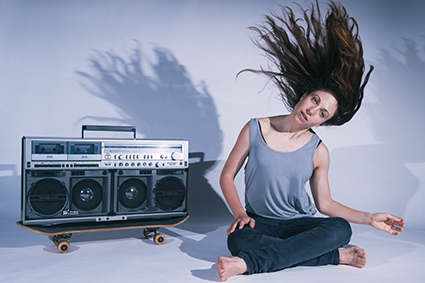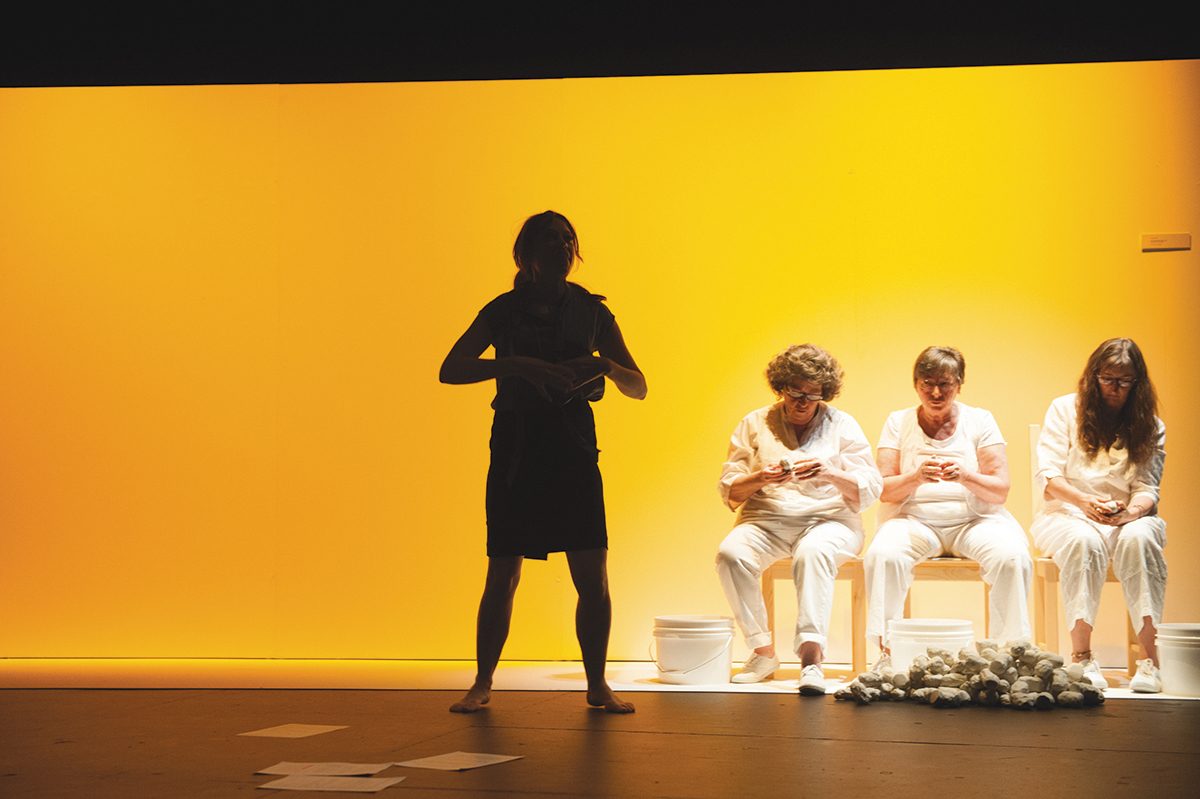The virtues of hopelessness
Professor Susan Becker: Nicola Gunn, Performance Artist
Nicola Gunn is a first-person performance artist. Since 2001 she has directed herself, performed herself and revealed herself. Sometimes she even tells the truth. But whether that truth belongs to her lived story or to the story of any number of Nicola Gunns in any number of alternative worlds remains uncertain. I don’t know. I am not Nicola Gunn. She has often talked about her mistrust of language, condemning its failures and inadequacies. Perhaps her inability to write narrative is why she chose performance art, as a kind of shorthand? She tells me, “My mother is a species of cat. She speaks a kind of cat language that not even the cat understands.”
Gunn works in an A5 black spiral notebook. She has a stack of 20, 30 maybe 50 of them in her IKEA Expedit. She uses a special pen in her notebooks: a .3mm black fineliner. People who know her know they must neither touch her notebooks nor use her special pen. “People often ask me when I’m writing in my notebooks, the pen in my hand, does it feel different? The answer is no. It feels like a pen.” She buys big rolls of newsprint, fills them with ideas and themes and then folds them up and puts them in a corner and doesn’t look at them again. She gets in a studio and generally spends three weeks in foetal position. She tells the girls in the waxing salon that she’s a graphic designer: “It’s difficult explaining to someone what you do when they’re looking at your arsehole.”
A woman of strong social ethics, yet very few personal morals, Gunn’s acclaimed body of work has always explored the role intimacy plays in geosituationalism. (I will discuss concepts of geosituationalism later on in this article.) And yet, pressed to define what she’s interested in, what she does and how she positions herself, she is enigmatically ambiguous: “I don’t know what I do or what I’m interested in.” The program notes to In Spite of Myself, her acclaimed work from 2013, offer some clues: “I spend a lot of time writing emails to community groups looking for old people. Last week I got in touch with Mary from the North Carlton Neighbourhood House and I told her I needed some old people for this show. She said, “What kind of show?” I said, “A show in a big theatre.” She asked me what was it about. I said invisibility, absence, irrelevance, the exploitation of marginalised sectors. She said old people don’t like going into the city at night. I said, have you asked them? She said leave it with me. At that point I realised I would not hear from her again.”
Further on, Gunn writes: “I’m concerned with social structures. I feel very strongly about working with real people and community groups, marginalised people and diverse demographics.” I’m not actually sure that is true. She has told me on numerous occasions that it was really really really really really really really really annoying getting the old women to commit and even more frustrating trying to schedule them because they never had their mobile phones on. She complained that they had their own logic for doing things that was totally out of step with the rest of the world. Like having mobile phones but not turning them on. Incidentally, old people do go out at night. I’ve seen them. They look like the visual representation of confusion.
By inviting the public into the act, Gunn is interested in subverting the economics of performance, where youth and celebrity determine interest. Her seminal 2012 work, Disappointment Mountain, continued the theme of cultural democracy evidenced in earlier pieces, such as Nicola Gunn Naps for Your Pleasure, in which an anonymous collector paid an undisclosed amount of money to have Gunn nap in their presence. Based on the success of the original performance, public demand to see the work and her commitment to dismantling the monetary emphasis throughout the performance art industry, she has repeated the event in various venues and continues to perform it regularly. (I was fortunate enough to see an impromptu performance myself during this interview.)

Nicola Gunn, Piece for Person and Ghetto Blaster
photo Sarah Walker
Nicola Gunn, Piece for Person and Ghetto Blaster
However, in Disappointment Mountain the audience is encouraged to make the work. The audience makes the art! It’s really exciting. The audience is content! Audience participants were encouraged to bring an object that represented a way in which they were unhappy in their life, or alternatively to create an unsatisfactory artwork and add it to the pile. They were then invited to take part in a one-off ceremony celebrating their dissatisfaction with the work. In this manner the artist reclaimed the theatre as a place where we form a temporary community and were inevitably let down by the experience.
Nicola Gunn says she hasn’t really thought about kids because she’s too busy. November will see her touring to Adelaide with a new work called Piece for Person and Ghetto Blaster. Except she didn’t get all the funding, so she might just call it Piece for Ghetto Blaster. She recalls how an ex-boyfriend once told her watching her make theatre is like seeing how sausages are made.
She describes the motivation behind I’m So Happy, the single-channel video work commissioned by Arts Centre Melbourne to activate its public spaces: “One morning, I was telling my flatmate about the Arts Centre and I realised what an aggressively inflexible building it was. As I was making my lunch for the day, I discovered a bunch of limp celery in the fridge. I didn’t think too much about it.”
Feeling that success might dull the critical edge of her work, Gunn continues to have a vexed relationship with the economics of the art world, an acknowledged ambivalence that has only become more felt as the artist increasingly receives commissions and financial support from major institutions. When you operate in the established system, somehow you have to maintain your ethics, integrity and most importantly, independence. Otherwise you face the threat of irrelevance. You’ll see it out the window and you’ll wonder if it’s lost but then you realise, no, no, it’s looking for a number. And then you realise it’s looking for your number and then you hear a knock on the door. “Success has in-built limitations,” she says. Coincidentally, this is what my change and transformation coach advised me this morning over coffee. (God knows my expectations have not been met.)
Gunn says she doesn’t plan what she is going to make next. To do so would be an exercise in hopelessness. She says it just comes, or it doesn’t. “I have to go through a kind of transformation or emptying in order for the idea to come. It can be very difficult and painful. It is rarely joyful. It can take a very long time, much to the frustration of my collaborators. I just know it will come because it must. I only ever work to deadline.”
Pressed to offer some kind of insight into this foray into the many worlds of Nicola Gunn, I find myself participating in what she has perceptively termed an exercise in hopelessness. ‘Hopeless’ because all writing, all thinking, all talking about performance that tries to capture its slippery character is a hopeless endeavour. And yet, I am hopeful that this attempt at a critical dialogue with one of the great mythmakers of the present will offer one more disappointment to celebrate at its end. Please allow me to add this to the pile with my sincere well wishes.
–
Nicola Gunn/SANS HOTEL, Piece for Person and Ghetto Blaster, Arts House, Melbourne, 11-15 Nov
Nicola Gunn is a performance artist, writer, director and dramaturg. She uses performance to reflect critically on its place in theatres, to examine power relations in existing organisations and to consider the relevance and social function of art itself. In August she premieres A Social Service at the Malthouse Theatre, a work set on a public housing estate. Her Piece for Person and Ghetto Blaster, commissioned by Mobile States and presented by Arts House, is described as “the story of a man, a woman and a duck…It is an attempt to navigate the complexities of trying to become a better person” (press release).
RealTime issue #128 Aug-Sept 2015 pg. 44







